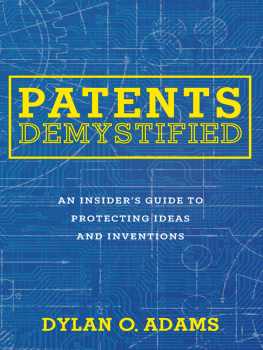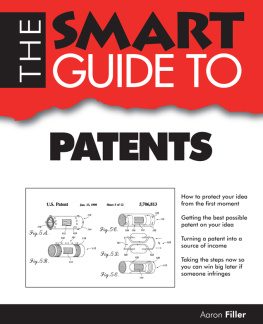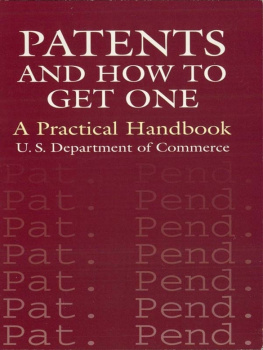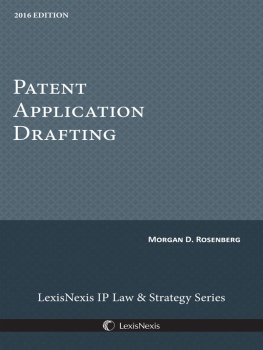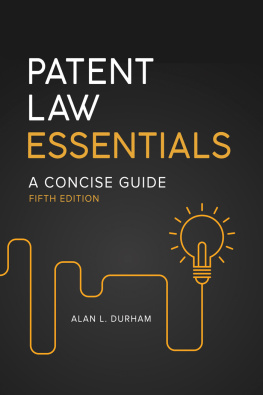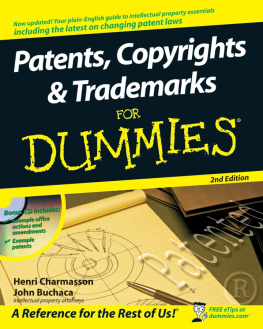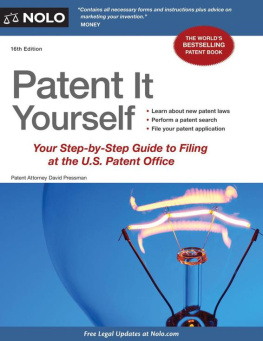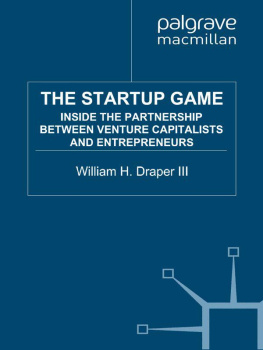THE PATENT GAME
Patent Basics and Strategies for Innovators, Entrepreneurs, and Business Leaders
Vance V. VanDrake, III, ESQ.
Copyright 2019 IP Ventures, LLC.
patentgame.com
All rights reserved.
ISBN: 978-0-9991144-2-1
All trademarks, brands, names, symbols, logos, and designs depicted in this book are property of their respective owners. They are used for identification and reference purposes only, and do not imply endorsement or approval of this book.
EditorKevin Michell
Legal EditorEric Robbins
Layout Editor, Book & Cover DesignBrianna Brailey
Published by Legal Technology Press, in the United States of America
Legal Technology Press
230 Findlay Street
Cincinnati, OH 45202

TABLE OF CONTENTS
PART 1: THE BASICS
Direct/Regional/National Stage Foreign Applications
PART 2: PLAYING THE GAME
Patent Plinko and Choosing the Right Patent Strategy
part 1: The basics
chapter 1:
the game
Either you play the game or let the game play you.
J. Cole
Many people may have the impression that the patent process is administrative in nature and to some extent this is true, but even within governmental constraints there is the enormous potential for variation and creativity. The patent process can seem like a uniform set of bureaucratic procedures not unlike renewing your drivers license, selling a car, or buying a house. However, the reality couldnt be further from the truth: The patent game is dynamic and multi-dimensional and, for those with a high intellectual property intelligence quotient (IP IQ, as Ill call it throughout this book), the rewards can be substantial. Playing the patent game well can lead to market dominance, higher business valuations, and financial success. Playing this game poorly can leave you, like the great inventor Nicolas Tesla at the end of his life, penniless and destitute. How well you play will materially impact your odds of winning this high-stakes game.
The patent game, like any other game, has its players, rules, board, pieces, power ups, timers, strategies, and tactics. Those with a high IP IQ have an advantage that allows them to dominate a technology sector, make a personal fortune, advance in their careers, and substantially increase the value of a business.
The ancient game Go, which is made up of a board with a 1919 grid of lines, black stones, and white stones, can seem deceptively simple to an outsider. Despite having very basic game pieces and relatively simple rules, Go is considered one of the most complex games played because of the sheer magnitude of possible moves (estimated to be at least 2 x 10, an amount that dwarfs the number of permutations in chess). Similarly, the patent game has a limited number of pieces with defined move sets, but the potential combinations in which these pieces can be moved in concert are numerous.
The first half of this book will introduce the basics of the patent game, who can play, what the global board looks like, the pieces that are available to players, and how those pieces can be moved. Once Ive taken you through these basics, well play a version of patent Plinko to help you determine which specific strategies are optimal for your invention or business. Each of the strategies Ill outline includes an introduction, typically with a game-related comparison, a step-by-step discussion of the strategy with graphics, pros and cons, and a practical real world example. Like any game, you need to learn the basics before you can move on to more sophisticated strategic considerations.
Not that long ago patent practitioners had to sell clients on the idea of protecting innovations with patents. That often proved challenging given the high costs involved with pursuing patent protection. These days the general public is savvy to the exclusionary benefits, seemingly overnight millionaires, and huge infringement judgments from patenting disruptive technology. Perhaps you have seen the high-stakes patent battles occurring between Samsung and Apple or Mark Cuban on Shark Tank grilling inventors about whether they have a patent in place for a new bathtub scrub.
It will seem daunting at first. When you first peel the plastic off a new board game, the players, rules, pieces, and strategies are completely foreign. It can feel like its going to take a lot of time and work to learn the game for very little reward. Starting the patent process can feel overwhelming, like trying to learn a famously complex game like Go or chess for the first time. Despite how it might appear from an outsider or first-timers view, the patent game is very approachable. And if you commit to learning the basics, your newfound skill will pay dividends.
Everyone knows that wonderful feeling when you finally get a handle on a great game. As you get more comfortable with the gameplay, your focus shifts from remembering the specific rules or individual pieces to developing a strategy to beat your friends and family. I see patent law as a vibrant and exciting board game and I hope youll come to see it in this same light.
Malcolm Gladwell was spot-on with his argument that mastery of anythingdespite what we might perceive as prodigious or savant-like talentis the product of a lot of time and hard work. No doubt there are aspects of your life to which you have dedicated enough time to become a true expert. But mastering the nuances of patent law probably isnt where youve chosen to spend your time. For one reason or another, though, youve reached the point where knowing the basics of the patent game has become important. Maybe youve taken on a new role at your job, you are finally ready to pursue that million-dollar idea youve been thinking about, or you work in venture capital and want to make better investments. You should take an active role in how your intellectual property is developed, protected, and enforced, regardless of whether youre a startup CEO, the head of engineering for a Fortune 500 company, or a garage inventor. Possessing a high IP IQ will help you communicate effectively and intelligently with investors, customers, your corporate board, and your patent attorney.
My goal with this book is not to instantly turn you into the equivalent of a chess grandmaster. As with any game, the players in the patent game have different levels of experience and expertise that arise out of some combination of interest and necessity. If, like me, you develop a passion for the nuances of patent law, I would encourage you to read this book cover to cover. However, if your needs are more specific, there are concepts you need to understand, or you need to quickly identify a patent strategy for your business, Ive formatted this book so that you can quickly and efficiently find the information you are looking for.
There are four primary intellectual property toolspatents, trademarks, copyrights, and trade secretsthat can be used to protect your business. Each has its own specific uses, term limits, functions, advantages, and limitations. This book focuses on patents while only occasionally touching on trade secrets when they are relevant to a patent-related strategy.
An exhaustive, textbook-like discussion of patent law can be a dense thicket of exceptions and nuance that can prove challenging even for the highly trained patent practitioner. This book focuses more on the general rules to arm you with enough information to sit at the board and play the patent game. Because no one understands your business and its needs better than you, the more clearly you can articulate your needs, resource constraints, and endgame in the context of a patent-related strategy, the more effectively youll arrive at an optimized solution.
Next page

